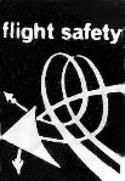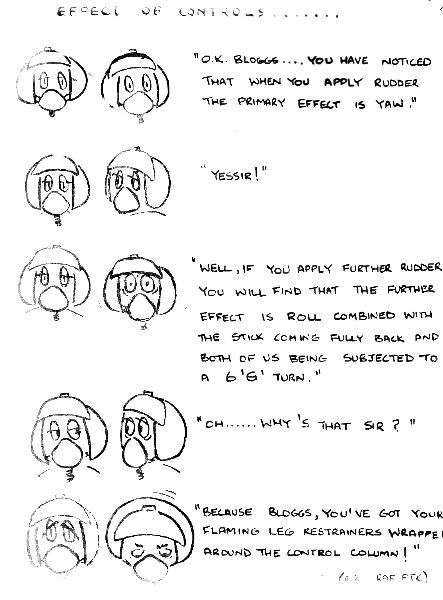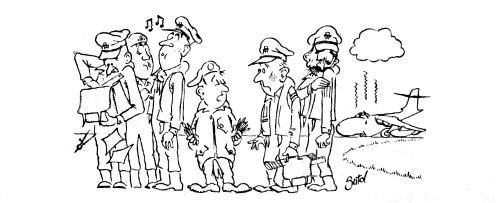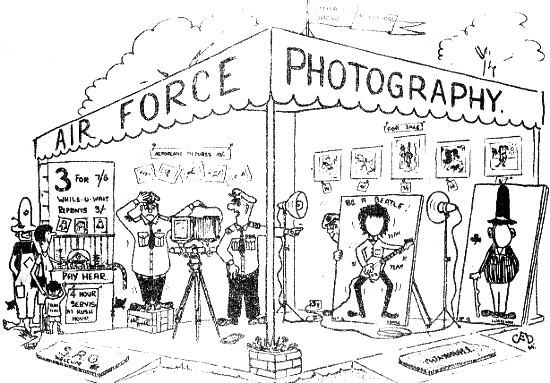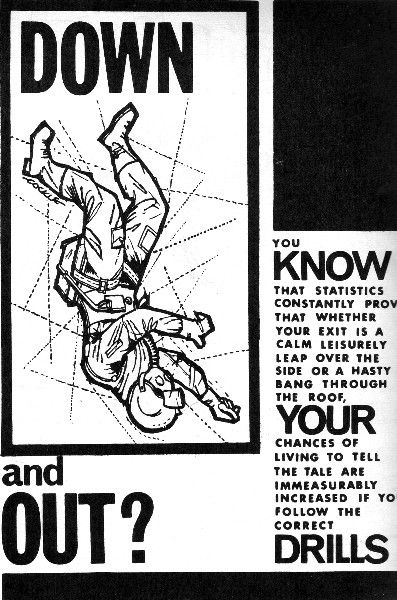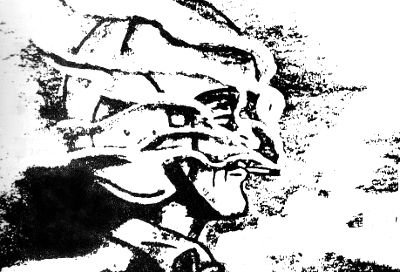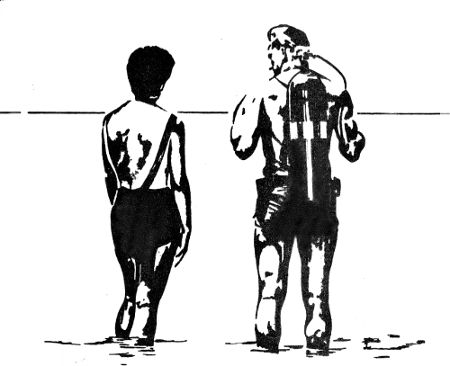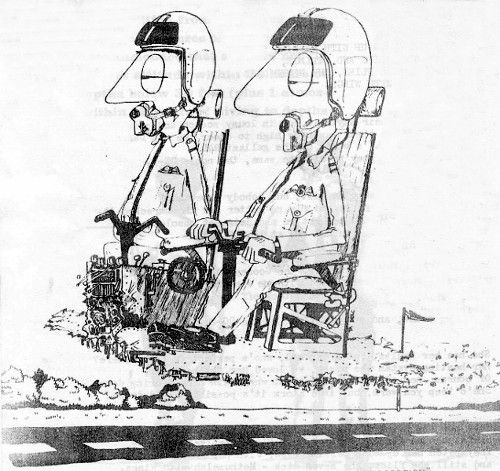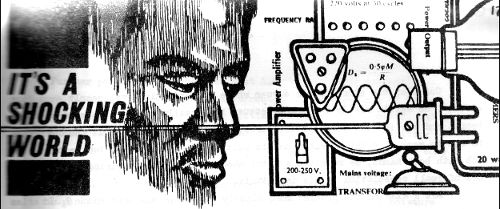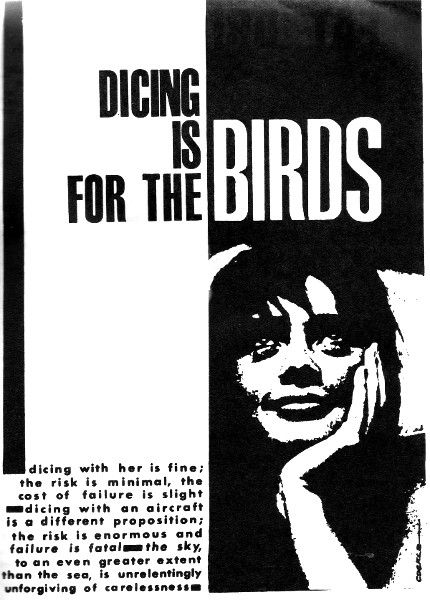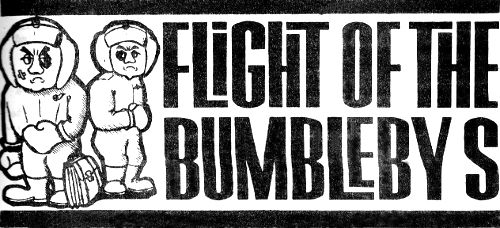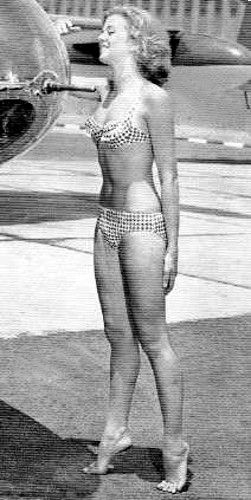Fledgling Magazine September 11, 1942

FLEDGLING
VOLUME 2: SEPTEMBER 1th, 1942: NUMBER 4
Address all communications to the Editor. I.T.W. Magazine, Hillside Camp, Bulawayo.
Published fortnightly.
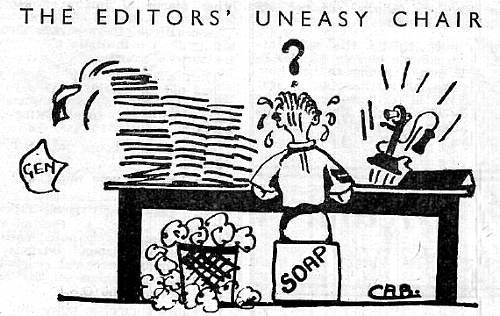
EDITORS' UNEASY CHAIR
A Welcome
FLEDGLING extends a hearty welcome to all the newcomers on the camp and hopes that they will have an enjoyable stay in Southern Rhodesia. For their benefit we should like to point out that Fledgling is the Hillside camp magazine and is published fortnightly for the benefit of all ranks who are stationed on the camp. We depend on contributions from members on the staff end from cadets in order to keep going. So if any of you new arrivals can write or draw, please send in any efforts to us as soon as possible.
Articles addressed to "The Editor, Fledgling," can be dropped in the Post Office collection boxes—so come along you chaps and get your stuff in print. The people at Home are very glad to receive Fledgling, so why not let our mail service keep your folks posted? If you are interested, all you have to do is to contact the Fledgling staff on the Fledgling table at the next pay parade.
On Dedigation
THE news generally has been more heartening lately and we think it is time that dedigitation (an exceller word which we have "borrowed from Tee Eimm) was practised on a wide scale. The first sign of dedigltating here was seen with the introduction of increased working hours, but in our opinion dedigitation should be matter of individual conscience an not by mass arrangement. Therefore, let us hear a fusillade of re sounding plops in the next few days even like unto the sound of many Brownings firing. Let this crescendo be heard in the air raid shelters of Berchesgarten so to that beastly little Austrian house painter it shall be a grim harbinger of what is coming to him. The young R.A.F. pilots are on the move in "statudidigitatus."
A Dream After The War
THOSE blasted crickets again— you can never sleep with those things
The year is 1950 and the scene is an ordinary home in the old country. The voice is that of a man who, like you fellows, received his training in Rhodesia.
"Be quiet Bill." His wife attempts to console him as she lies in bed still awake owing to her husband's unusual restlessness. But no response is forthcoming, for the husband—who might be you— is sound asleep in the land of dreams with the sky clear of war clouds.
His restlessness? His mind is in distant Rhodesia recalling those golden times with the R.A.F. in that sun-kissed country. A normal day is recounted in his reverie.
His features are grim, for he is now performing that most feared event of the day . . rising, or to the uninitiated "getting up." "Hurry, up," one of his more active colleagues ejaculates as the 0730 hooter woefully screeches in the ears of the slumberers and "sleepers off."
He turns over on his side with a sigh of relief. Unobserved by the hawk-like eyes of Sgt. Bottomings he has succeeded in procuring a place among his flight on parade.
His body is restless as his pals inform him of an inspection by P/O B. He tucks his unshaven chin well in as the officer inspects the front rank, while his feet begin to kick in an unusual manner.
"For Heaven's sake, keep still," exclaims his wife . . . but it continues eventually his boots are free from the day's old smearing of dust collected the day before.
His face reddens. He has not evaded the attention of old B. in or- der to sneak into the front rank already inspected. Another sigh B. has passed him
"Thank goodness it wasn't M.. he murmurs in his sleep.
In his dreams those memories of the lecture huts, of the range and other places of torture sweep up. Sergeants D. and E., officers P. and F. and all the others parade through his mind in a majestic cavalcade of treasured, memories.
Then a look of awe on his face has old B. accepted his pal's excuse for his non-appearance in class without investigating at S.S.Q.?
And those hours of P.T. he skipped.
His brow is now moist and perspiring fiercely.
Oh yes—those never-to-be-forgotten b.....s____ (button stick to you sergeant) parade mornings when running around latrines and dodging here, there and everywhere he eventually shakes off his determined pursuer the O.S.
A look of surprise now—that was the one day he turned up for P.T., and it was marred by the instructor's remark, "Are you in this flight?" But what is this change his mind has left the camp behind. He wets his lips as he recalls those gay times in the Grand and the Carlton.
Twenty-three fifty-nine has long gone and as darkness gives way to dawn he leaves a piece of his trousers on the barbed wire entanglement as he stumbles over it. "Yet another defeat for old doings intendedly invincible barrier." He smiles.
By this time his wife had endeavoured to wake him up several times, all without success and just as he is recalling his fall from grace by saluting without a cap he suddenly jumps out of bed groping and calling for his hat.
He is just in time to see his usual morning bus flashing past the window. A walk to the office confronts him.
"Serves you right," snaps his wife.
"But it was worthwhile the dream," he thinks.
They weren't bad memories after all were they chaps?
Written by: SCLAITY INN.
Lexicographer Writes
In consequently Yours
I THOUGHT I would turn my hand to sports writing, so here I go with the match between two sets of the staff—those in "Z" lines and those in Hut 42.
The match was well attended by both teams—eleven players turning out for both sides after fifteen minutes' play. The final score, 1—1, was no indication of the state of play, I have never seen so many brilliant (pronounced lousy) inter- changes of play—at one time Hut 42 looked very dangerous when six of their players congregated on the left wing, but unfortunately the ball was on the opposite wing.
The first half saw Hut 42 pressing very hard—short determined rushes through the dust was the order of the day—sometimes with the ball, much to the surprise of their opponents. They scored quite well with Jimmy Wigan kicking up a terrific dust storm which blinded the defence of "Z" Lines so that his oppo' could nip smartly round and score.
Not to be outdone, "Z" Lines went into a huddle in the second half and did a spot of extractum digitorum and starting with some ring work from Tucker of Temperance fame, whose training on beer was extremely effective; a pass to Douggie at half- back, through to Nobby at full-back, resulted in a goal from the canteen side.
Extra time was needed, but neither side could crawl fast enough after the ball and no further goals were added.
A word of praise to the ref., who played very well for the crowd.
***
I heard our dumb Waasle talking: to her friend the other day, or rather tearing- her off a strip of something or other:
"She told me you told her the secret I told you not to tell her."
"The cat, I told her not to tell you I'd told her."
"Well, don't tell her I told you she'd told me."
* * *
Have you heard about the light that failed to go out? You haven't?
Well this is the conversation arriving from that happening:
***
'I hear you had a lot of trouble getting married old boy. Did her father come between you?"
"No, behind us." (And they told me you could not get shotgun ammunition).
* * *
Flash: Latest service gen In the form of a howler—"Servlce Ceiling" is the height that an aircraft will
not carry out it's functions correctly.
* * *
A pal of mine went to a civvy doctor the other day with a very bad cold and sore throat which unfortunately reduced his voice to a whisper. He reached the door and rang the night bell and a voice came through the speaking tube: "Hullo, what do you want?" My friend answered in a whisper: "Is the doctor in?" The lady's voice in a similar whisper said "No, come in,"
* * *
This week's topical verse:
Hickory, dickory, dock,
The C.O.'s got a new clock-
To tell all the camp
He put it on the amp'
Now they can hear it "en bloc."
* * *
Test message—"What's yours?"
L.D.A. HOWLERS.
(Being actual answers in an L.D.A. examination set to u/t Air Gunners).
* * *
An Impending Apology to the Yogis.
The Fleet Air Army wear navel uniform with the letters F.A. on the sleeve.
***
"Uncle ' Again. BOLD
A Lieut-General in the U.S.A. Air Force wears three golden balls on the epaulet. (Personally, we wear chiffon pants with the letters R.D. on the seat).
Model Aero Club
GREAT success at second Induna rally. Success? Perhaps that word does not mean as much to my readers as to many members of the Model Aero Club where rallies or inter-station flying is concerned, however success of any sort means great achievements and large strides in progress.
We had a taste of this success on August 30th, when the second Induna rally was held. Members put up one of the best exhibitions of model flying as yet seen. The Induna lads were surprised greatly when L/A/C Lawton's model made a record breaking flight of five minutes, thereby raising the existing club record by three minutes. However, Induna's record of six minutes 30 seconds still remains to be beaten, and at the present rate of progress it is hoped to raise the record and hold if for all local stations in rubber duration flying.
The petrol enthusiasts of the club did not put up as good a show as was expected, but it is hoped in the near future to see another three petrol models completed—perhaps in time for our next rally which is being held at Induna on September 13th.
The proposed four station rally on August 23rd, turned out to be a failure due to the very high prevailing wind. However, a few daring modellers flew their machines—with expected results—still no complete "write-offs" were recorded.
Induna at present lead the Indoor flying field, but are being closely rivalled by other stations. Indoor meetings are to be held shortly, so opening up another field of model aviation. Many modellers look forward to the time when model flying will become as well known as other sports in the Group, and the ultimate end of a Group rally may then become possible.
I.C.
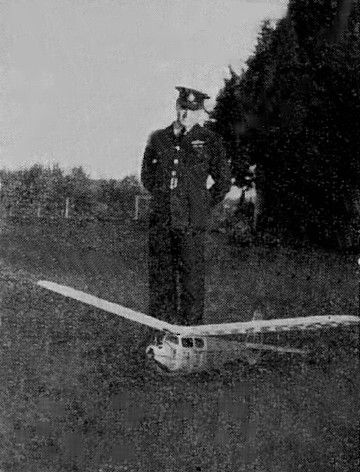
LETTERS TO THE EDITOR
To correspondent O.A.T.S.:
We regret we are unable to publish your letter and suggestion, but we have taken it to the Messing Officer who has promised to put the suggestion before ths Airman's Messing Committee.
Thanks for writing.—Ed,
* * *
APPRECIATION.
85, Hirst Gate,
Mexborough,
Yorkshire.
Dear Sir,
May I express my appreciation of the system whereby your magazine Is sent to relations and friends of the men in Hillside Camp, left behind in England. You cannot conceive what joy it gives me, as the wife of one of the men, to receive it regularly. I look forward to each number eagerly, as I feel it helps so much to shorten the immense distance between us and you. What joy there is in reading the articles written by our men folk, especially the ones which help us to visualise life in Hillside Camp, and the activities of the men. I'm sure there must be many more of the "left-behinds who feel as I do and who hope you will keep up the good work.
As for the men who have women folk here, and have not yet thought of sending them the magazine, do urge them to try it, as I'm sure it would be a real tonic to those who are just waiting, as I am, for a certain great day to arrive. The magazine is worth its weight in gold.
May I wish you every success in your future numbers.
Yours sincerely, Joan M. Saville.
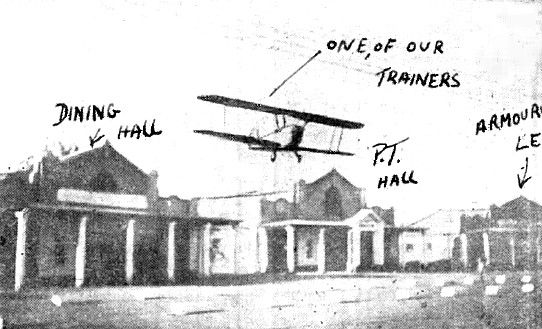
A Cockpit-Drill Instructor comes into land at Hillside
A QUIET MOMENT.
The handclasp of a faithful friend;
The inn that's at the journey's end;
A wind-swept hilltop, where the view,
Comes flooding up to welcome you;
A twisting path 'neath shady trees;
The cold, metallic ring of keys;
A roaring fire—when beating rain
Rattles against the window pain;
Fine music, and well-earned applause.
The crusting touch of canine paws;
A quiet street with lamps alight
Spreading their radiance through the night;
Old clothes, a pair of well worn shoes;
The gallant smile of those who lose;
The clock which marks each tedious hour
By chime of bells from some church tower;
And home—where love and comfort are
Ever found—the guiding star.
Familiar things we know too well,
Who can, in full, their true worth tell?
H. Saville.
Native Boxing in Southern Rhodesia
I WAS recently given the privilege of watching a native boxing competition in the location at Bulawayo. It was organised and refereed by the Native Welfare Officer, Mr. Lewis, and it was through his kindness that I was able to attend.
The boxing took place behind the main hall and to assist in keeping the crowd down to a manageable number, an admission fee of one penny was insisted upon. Even then, the average native's wage being small, approximately 1,800 natives attended.
The boxing: ring itself was of regulation size and properly roped, built on brick foundations. The ring side seats, consisting of one row of forms around the ring, are reserved for contestants. Behind this row is a wire netting fence about three and a half feet high and there are more seats behind the fence.
The crowd split themselves into tribes as far as possible. The main tribes, the Mashona and the Matabele, facing each other, .while remaining tribes and neutrals form the other two sides of the square.
A set programme of bouts cannot be arranged, for owing to tribal custom no two natives from -the same tribe will. box each other. A bout is arranged by a challenger from one of the tribes climbing into the ring and waiting for an acceptance from another tribe. Should no one be forthcoming, after about thirty seconds the bell is. rung and the unaccepted boxer leaves the ring, his place being taken by another challenger. Eventually the challenge is accepted and preparations for the fight are made. There is no question of equal weights, but if they are obviously unequally matched then Mr. Lewis does not permit the contest to proceed. *
Of the officials, the Welfare Officer acts as the referee and a native acts as a timekeeper, while another boy has the role of announcer and interpreter. "Michael" is usually chosen—he is the leader of the Pathfinders (the native equivalent of our Boy Scouts), and he takes great pride in his job.
Quite a number of the contestants wear lucky charms or jujus—perhaps some powder in a piece of cloth tied to his arm, or a small piece of horn containing black magic tied to his belt. Their shirts are very often of quaint design and contain a good deal of colour. On numerous occasions their name is sewn on their skirts as in first class European boxing, while one, apparently a member of a local R.A.F. station, had the words "Air Force" in pink ribbon on his back. He was very popular with the crowd, but unfortunately did not manage to win his contest.
The boxing itself is not of a very high standard as compared with our standards. Skill is forsaken for slogging—they merely slog at each other and Heaven help them if the blows land. I have often heard that the average native's head is very tough and after the way they simply well each other and come, up for more I can assure you that this is perfectly true.
The Welfare Officer has managed to train them very well and they all understand that it is forbidden to hit below the belt, and he always gives them a word or two of warning before the contest begins.
The Welfare Officer has managed to train them very well and they all understand that it is forbidden to hit below the belt, and he always gives them a word or two of warning before the contest begins.
From my own observations they seem to show quite a good deal of sportsmanship in the ring and they do not take any unfair advantages of their opponent. Their conceit in the ring is absolutely amazing— they prance around in typical Max Baer style and play to the crowd a great deal. If sufficient applause is not forthcoming then they even go to the length of asking for more!
If victorious, they are delighted, and immediately shake hands with all their friends within reach, but on the other hand if they are beaten they adopt a very crestfallen attitude and look very sorry for themselves. It seemed as though they were all fighting for the honour of their tribe rather than for
personal reasons.
I found the reactions of the crowd very amusing to watch. Each punch was closely followed, and judging from their facial contortions and body movements, many of the audience imagined they themselves were in the ring. Cheers and shouts of encouragement were the order of the day during the actual rounds, while during the interval a hum of conversation immediately broke out as they
discussed .the progress of the fight.
As at all sporting functions the police were in attendance, and in this case only two European policemen were there to keep their eye on things In general. A hosepipe is kept already fixed up and besides being used for an outbreak of fire it comes in very useful to quell the ardour of the crowd if it becomes too heated. It has another use namely, to quench the thirst of ringside members. One poor
chap was getting his drink when a practical joker turned the Water to full force and besides giving the drinker a shower, I, too, was liberally sprayed much to the amusement of the crowd.
I must say they seemed to be a very orderly crowd. A very short while after the competitions had ended the crowd had all dispersed. I cannot say that they went quietly away, for there were many discussions being held as they filed out of the gates.
It says very much for the tact and ability of the Welfare Officer to handle such a very entertaining afternoon's sport without any assistance whatsoever. It also reflects greatly on the natives that there were no disturbances or demonstrations of any kind.
U.A.P.
***
FROM THE B.B.C. LONDON LETTER.
Tommy Handley's New Baccy. Greenfell Finn Smith, the irrepressible compere of "Songtime in the Laager," (broadcast in the B.B.C'S African Service) likes springing jokes on the artists before the show begins. He's fond of giving a piece of biltong (dried buck) to the uninitiated. Tommy Handley tried to smoke his and complained disgustedly that it wouldn't draw. Three stars were several seconds late on their cues because they found some difficulty in disposing of their "chewing gum." Gillie Potter preserved his piece as a "relic of a better world."
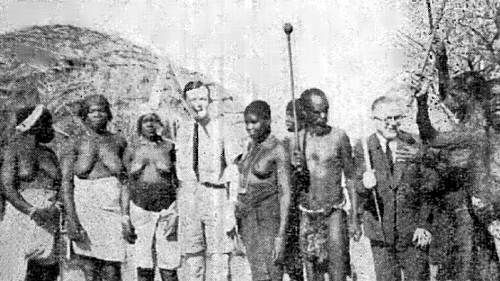
One of these is a P.T.I.
STATION SPORT
R.A.T.G. Cup Won after Grim Struggle
I.T.W. 6, THORNHILL 3,
I.T.W. justified the confidence which has been placed In them throughout the present season The win at Gwelo against the cup-holders was decisive.
From the start of the game Thornhill appeared determined to confine the game to the forwards and thus prevent the speedy backs cf I.T.W. from getting the ball. In their efforts to keep the ball from reaching Huskinson, Saunders and Swallow, their forwards were over-eager and I.T.W. profited by the award of several free kicks for off-side. Swallow took the kicks and scored on two occasions to give I.T.W. a six points lead.
On the few occasions that the I.T.W. backs got into motion, things seemed very dangerous for Thornhill, and Huskinson and Springer came very near to crossing the line.
The second half was mainly a tussle between the two packs. If anything, LT.W. were superior both in the set and loose scrummages. All I.T.W. forwards played sterling games, and mention must be made of the great solid work done by Jenkins, Painting and Wiltshire. Collins, too, in the line-outs, despite the handicap of a dislocated collar bone, was outstanding.
During the second half Thornhill were unfortunate enough to lose their fullback with a broken ankle. But they continued to fight back and from an attempted drop-goal Thornhill touched down for the only try of the match.
The closing minutes of the game were full of expitement, with I.T.W. attacking hard. There was, however, no further score.
P/O Painting, the skipper, was "chaired" off the field to receive the cup from the A.O.C.
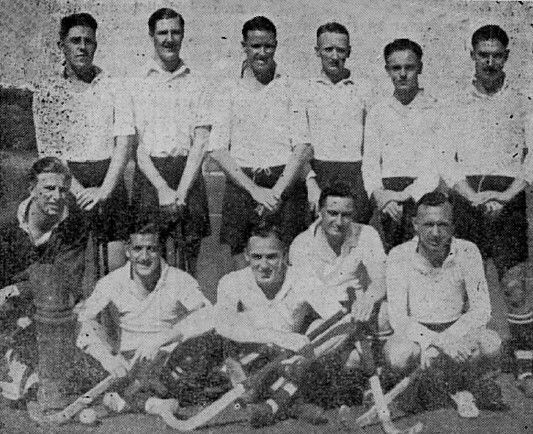
I.T.W. Hockey Team
ROVERS SHAKE US
SEMI-FINAL OF MACGILLIVRAY CUP
I.T.W. 3, ROVERS 2.
I.T.W. played a newcomer to Rhodesian football in Ball at left wing, and he gave a very good account of himself.
At the start Getty made a brilliant run through the Rovers defence, but could not get his shot in, so he passed across to Irvine who shot wide.
At one period of the game all the I.T.W. players, with the exception of Stone, were in the Rovers half of the field, and even Scott went up and gave Munnick, the Rovers goalkeeper, a good shot to handle. It was all I.T.W. and Getty made another solo run, but finished weakly by kicking into the goalkeeper's hands.
The I.T.W. players eased up and the young Rovers team took advantage and made a quick getaway and forced a corner, the kick was, however, easily cleared by Spalding. They made another attack and Feldman placed the ball across, but the players in front of goal missed it. It went to Rorke, who had hard luck when he hit the side of the net with a good shot.
A good piece of interception by Picket set the I.T.W. left winger going, and he quickly rounded Paxton,but spoilt it by shooting into Munnicks ever open arms.
From a throw-in the Rovers made a fast break through, but a timely- run across field by Shearon saved the situation.
The I.T.W. team started to wake up and Spalding threw the ball to Dodd, who returned it for Spalding to kick it across the field, where Ball was waiting for a loose ball, he banged this hard, but Munnick was well positioned and saved.
At the other end the Rovers missed a golden chance of scoring when one of their forwards shot wide. A bit later Edwards ran in after Picket had missed the ba1! and shot in, but Steward dashed in and cleared near the gcol line.
There was no score at half-time. I.T.W. had a shock in the first few minutes of the second half when the Rovers went straight through and scored, Feldman beat Stone with a really fine shot. I.T.W. were awarded a free kick just outside the penalty area and Getty took the kick, Munnick stopped it but failed to hold it, and Dodd ran in to bang home the equaliser.
The second I.T.W. goal was the result of a nice move by Irvine, who put the ball for Jinks to run through and score a beauty. The Rovers were always ready for an opening and Edwards worked his way through but finished weakly.
Dodd gave a beautiful back heeler to Getty, Getty ran out to the wing and centred, Jinks met it first time and had bad luck to just put it the wrong side of the upright. Scott had many a tussle with Feldman and near'y always came out on top, but the Rovers centre forward moved out on to the wing and made a good run before putting the ball across, both Stone and Steward jumped for it, the ball dropped near Rorke, who gave Stone no chance to recover.
A grand piece of football by Ball and Shearon was deserving of a goal when S'learon sent in a difficult shot which Munnick did well to hold.
A Jinks-Getty move produced I.T.W.'s last goal, the last named player ran in and put the ball past the goalkeeper. The final score was 3—2 in favour of I.T.W., and so they once again qualify to play in a cup final against a Heany team. For date, time and venue keep your eyes on the notice board.
Teams
I.T.W.: Stone; Steward, Picket; Spalding, Scott, Shearon; Dodd, Getty, Jinks, Irvine, Bill.
Rovers: Munnick; Paxion, Le Roux; Baker, Candle, Beretta; Edwards, Paxton, Feldman, Barbour, Rorke.
SOCCER LEAGUE
Defeat
I.T.W. 0, Kumalo 3.
The match between the leaders of the league was a typical end of the season game, both sides failed to produce anything like their usual form. Jinks playing at centre-half passed the ball to Shearon, and the left-half sent Truman down the wing, for him to finish off the move by sending across a centre which Jackson ran out and caught.
At the I.T.W. end a mis-kick by Steward let Dowden through, but he shot wide. Another effort by Jinks, Shearon and Kilshaw ended by Miller kicking forward for Jackson to pick up and clear.
The Kumalo left-half slung: the ball out to Dowden and he put a good centre across, Tapper got the ball under control, but held on to it too long and was robbed by South, who finished poorly by kicking into Leniston's hands.
Kilshaw got his wing man away and Truman put over a long centre, Martin ran In and headed into the goalkeeper's hands. Truman lying well up the field received a pass from Kilshaw, he took the ball on and shot but Parker blocked it and gave away a corner kick.
The ball was kicked to the other end and South put in a good header. A little later this same player beat Leniston with a ground shot, giving Kumalo the lead after 25 minutes tame football.
I.T.W. moved up again and Tru- man gave McAdo a pass which the centre forward put over the bar. Martin sent in a good shot, but Jackson was ready and saved.
Half-time: I.T.W. 0, Kumalo 1.
Kumalo in this half increased their lead, while I.T.W. fell away. In the opening stages, Kilshaw received the ball and put a pass down the middle, McAdo gathered it and beat his man on the run but was put off his shot by Parker.
Tait, when taking a shot at goal, injured himself and went off, but soon returned and played on the left wing, Dowden going to inside left. Leniston did well to run out and save from Moody, but Kumalo were not to be denied and Dowden beat the I.T.W. goalie with a cross shot. The same player hit the crossbar and Jinks headed clear. Kumalo's third goal was scored by their right winger.
Teams:
I.T.W.: Leniston, Steward, Tapper, Spalding, Jinks, Shearon, Martin, Miller, McAdo, Kilshaw, Truman.
Kumalo: Jackson, Parker, Thompson, Marshall, Gill, Collinge, Moody, Findley, South, Tait, Dowden.
Victory
I.T.W. 4. Heany B 3
FOR this mid-week game I.T.W. fielded a team composed mainly of second eleven players. The Heany wings were given too much scope, and Frazer soon tested Kilacos with a difficult shot which he dealt with in a masterly manner. Then the I.T.W. left wing pair got weaving and a ball came across which all the forwards missed except Miller, who banged it back into the goalmouth but Waddle headed clear.
Heany were awarded a penalty kick, and Hawks scored with a strong well placed shot. The I.T.W. players took the offensive and McAdo gave a high kick up field, Irvine jumped and headed forward, Dodd ran in and smartly kicked the ball over Bowman as he ran out, and Miller put the ball into the empty goal.
Heany made a fast attack and Scott partly stopped a shot which continued to move goal wards, but Kilacos was on the alert and promptly dropped on it. Dodds paved the way for I.T.W.'s second goal, and it was from the winger's pass that Oakley beat Bowman with a shot.
Heany kept trying and Scott when hard pressed made a short kick back to the goalie, Fairfoull quickly cut In, but a daring dive by Kilacos saved the situation. Bennet upset the Heany attacks many times by his fast first-time kicking. The Bushmen forced a corner, and Frazer placed a good ball across which dropped near the unmarked Moffat at tne foot of the goal post, and he only had to touch it to score.
Just before half-time some nice play by Dodds and Irvine was rewarded when Irvine crashed home a beautiful shot from well out to give I.T.W. the lead.
Half-time: I.T.W. 3, Heany 2.
After some rather mediocre play by both sides, Heany equalised when Hoy, with a fine burst of speed, beat the defence and passed to Kennedy who scored a fine goal. Heany made several breakaways but the keen tackling by Picket and the ex- cellent defensive play by Scott caused many an attack to fizzle out.
When it looked as though the match .was goiyg to end in a draw, Getty broke through and scored the winning goal.??"
Teams:
I.T.W.: Kilacos; Bennet, Picket; McAdo, Scott, Harrison; Miller, Getty, Oakley, Irvine, Dodd.
Heany B: Bowman; Waddle, Lawson; Hawks, McGall, Hoy; Frazer, Fairfoull, Kennedy, Best, Moffat.
Friendly Matches
HEANY B II 4. I.T.W. II 0.
This was a very poor game to watch, and both players and spectators were glad when the final whistle blew. The Greek players deserve mention if only for their whole hearted efforts, but the Heany team were always on top and were easy winners by four goals.
On behalf of the players and the few supporters, we thank the Heany Club for its grand hospitality extended to us in the shape of refreshments and a light meal. I.T.W. please note!
***
I.T.W. II 2, HEANY II 4.
This game produced some exciting movements, and the spectacular play by Kilacos in goal surprised and delighted most of the spectators. The Heany eleven played better as a team and Close was a source of danger. Heany took the offensive and Close put in a hot-shot which Kilacos dropped, but he made a wonderful recovery by pouncing on the ball and covering it with his body.
I.T.W. drew first blood, Popovitch ran out on the wing, took the pass and beat Barber, who went over the touchline, but as there were no linesmen he was allowed to continue and from his centre Bennet scored. A bit of bustling play by Martin nearly got a goal, but the score at half-time was unchanged.
In the first minute's play of the second half Heany were given a penalty and Elford made no mistake with a strong shot. Heany kept up their attack and Hall had the bad luck to put the ball into his own goal when trying to stop the winger.
A nice bit of approach work by Quigly and Airy resulted tn Wheeler heading past Kilacos to score the fourth goal.
I.T.W. kept on trying and Hemmings put a high bail over; Martin cut in and headed to Bennet, who put it out of Maloney's reach."
Teams:
I.T.W.: Kilos; Hall, Pickett; Phillips, Harrison, Rickets; Hemmings, Popovitch, !Legerwood, Bennet,
Martin.
Heany: Maloney; Elford, Fisher. Puttich, Snape, Barber; Close Fowles, Wheeler, Quigley, Airy.?
Last Minute Goal Wins Celtic Cup
I.T.W. 4., HEANY A 3.
(Irvine 2, Jinks 2) (Cranbie, Kimpton, Steward, one goal.)
RIGHT up to the last minute this was anyone's game, and I.T.W. were perhaps lucky to win. At the very beginning the Heany forwards nearly rushed the ball into the net.
A free kick against Tapper, looked dangerous, but Steward got his head to the ball and the situation was eased. Both Jinks and Getty were robbed by Moss, when it looked as though the I.T.W. forward line were going to get into their stride. The ball was in the I.T.W. half for most of the play, and Heany were unlucky when Steward stopped a sure goal at the foot of the post.
I.T.W. looked like scoring when Jinks received the ball from Stone's kick-out, and ran through, Woan ran out and Jinks lobbed the ball over his head, but it went the wrong side of the post.
Heany pressed hard, but Tapper kicked clear; Jinks got the ball and passed to Truman, and this player put across a good ball which Irvine banged into the net. Immediately afterwards Heany were awarded a penalty for hands, but Stone saved and cleared.
Heany equalised, when after a fine piece of work by the right wing Cranbie crashed home a grand shot. Five minutes later, after 35 minutes struggle, Jinks made a fine solo effort and put I.T.W. ahead with a pile driver of a shot.
Half-time, I.T.W. 2. Heany A 1.
The Second Half.
The exchanges in this half were fast and often. Heany were determined to even things, and it was only Scott's headwork that stopped them getting through on many occasions. A combined Shearon- Kilshaw-Getty move nearly brought success when Irvine headed Getty's centre outside of the post. Spalding and Kilshaw tried to get through, but Moss intercepted and transferred play to theI.T.W. area.
Heany equalised when Steward deflected a shot from Kimpton into his own goal. Kimpton at this stage was playing well, and he cleverly beat Tapper and shot from close range giving Stone no chance. A good tackle by Tapper and a good pass sent Jinks away, he took the ball right up to the penalty area before shooting, and to everyone's amazement Woan misjudged the ball and it entered the net.
I.T.W. were now pressing hard, and just before the final whistle, Irvine beat Woan with a first time shot for I.T.W. to become the winners of the cup.
The teams were:
I.T.W.: Stone, Steward, Tapper, Spalding, Scott, Shearon, Getty, Kilshaw, Jinks, Irvine, Truman.
Heany: Woan, Millward, Rice, Main, Moss, Geddes, Kimpton, Nash, Crombie, Brown, Airey.
THE LION AND THE JACKAL
Do you remember the fairy tales of Hans Andersen and Grimm that you read in your infancy? In all probability you could still recount your favourite right now. It's funny how those old stories stick in our minds—I have heard of adults who have come across Hans Andersen's Tales and have re-read them, so fascinating are the stories even to an adult.
"The Lion's Share" is a form of fairy tale—a native tale— possibly it has an inner meaning that I can't say, but it is certainly attractive.
THE Lion and the Jackal were once out hunting together. The lion shot an arrow but it fell short, so the Jackal tried and managed to hit the game—"I've hit it,''' he cried joyfully. The Lion turned and glowered at him so the Jackal said hastily, "No, Uncle, I mean to say that you hit it."
They fallowed the game, passing the Lion's arrow, which the Jackal was careful not to notice. Arriving at a fork in the path the Jackal said " Uncle, you must be tired. Stay here and rest." This the Lion was glad to do.
The Jackal left him and deliberately took the wrong track and as soon as he was out of sight beat his nose, letting the blood from it drop on the path. He then returned and said to the Lion, " I could not find anything but there were traces of blood. You had better go and have a look for yourself while I go and try the other path."
The Jackal soon found the dead animal and creeping inside of it devoured the best parts; however, his tail remained outside and when the Lion arrived he took hold of it and dragged the Jackal out and threw him on the ground saying, "You rascal! " The jackal quickly jumped up, complained of the rough handling and said, "What have I done to deserve this? I was only cutting out the best parts for you."
The Lion was appeased and said, "Let us go and fetch our wives to share in the feast," but the Jackal would not hear of the Lion moving, saying that he would go for both.
When he reached his own house he told his wife to go at once to the place where the killed game was lying. The Lioness hearing the movements, in her neighbour's house wanted to accompany them but the Jackal told her that the Lion would come and fetch her and that he would be angry if she came without his permission.
Just before reaching 1he spot where the Lion was waiting the Jackal ran into a thorn bush, scratching his face so that it bled. He staggered up to the Lion and said, ''What a wife you have. Look how she scratched my face when I told her to come with us. You must fetch her yourself."
The Lion set off home in a rage and directly he was out of sight the Jackal said to his wife, " Quick, let us build a tower." So they heaped The Lion set off home in a rage and directly he was out of sight the Jackal said to his wife, " Quick, let us build a tower." So they heaped stone upon stone and when the pile was high enough they carried everything to the top of it.
When the Lion and his family returned the Jackal cried out to him from the top of the tower. "Uncle, while you were away we built a tower in order to see more game."
" Alright," replied the Lion, " but let me come up to you."
"Certainly, Uncle, but how will you manage it? We must let down a thong for you."
So the Lion tied himself to the thong and was drawn up, but when he was nearly at the top the Jackal cut the thong, exclaiming as if in great fright, "Oh, how heavy you are. Go wife and fetch another thong."
The Lion was again drawn up and again the Jackal cut the thong.
" This will never do," said the Jackal, " but you must come up high enough so that we can at least give you a mouthful." So he told his wife in a loud voice to get a specially strong thong. In a whisper he added instructions for her to make a stone hot and cover it with fat. Then he drew the Lion up once more and when he was near the top told him to open his mouth. The Lion did so. whereupon the Jackal threw the hot stone down his throat.
When the Lion had devoured it he rushed off to the water hole, leaving the Jackal and his wife to eat the meat in peace.
***
SHAKESPEARE KNEW .
Before a Session.
"We'll teach you to drink deep ere you depart." (Hamlet).
During.
"Come sing me a bawdy song Make me merry." (Henry IV).
***
After . .
"Nor heaven nor earth have been at peace to-night." (Harold).
"Peace, good pint pot." (HenryIV).
"But soft! Methinks I scent the morning air!" (Harold).
***
What the Cadets Say.
"I am slow of study." (Merry Wives of Windsor).
"I do begin to have bloody thoughts." (Taming of the Shrew).
"What is the opinion of Pythagoras concerning wild fowl?" (Twelfth Night).
On Plotting.
"Leave no rubs or botches on the work." (Henry IV).ly he was out of sight the Jackal said to his wife,"
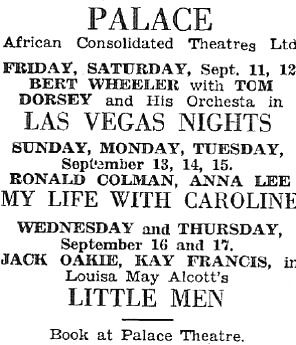
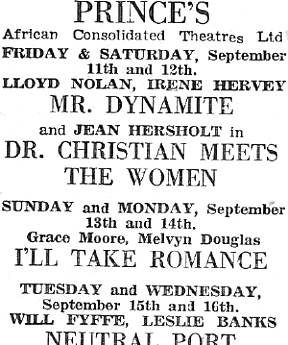
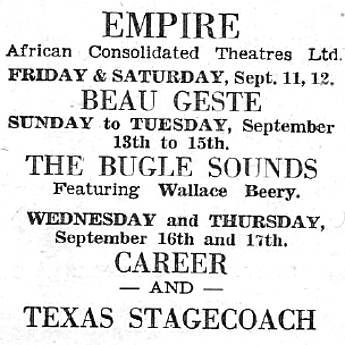
End of Magazine
The following advertisement appeared in this magazine.

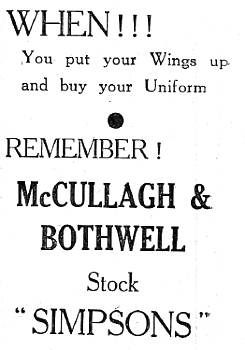
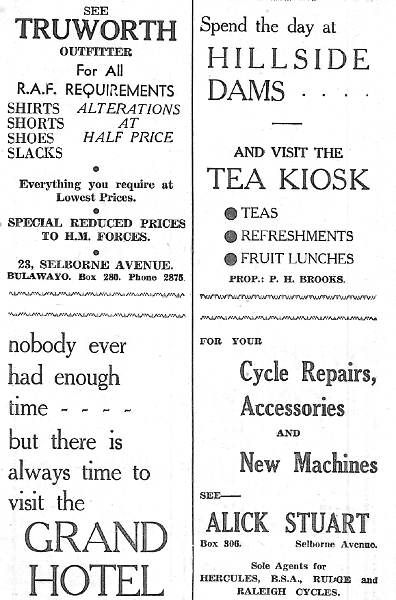
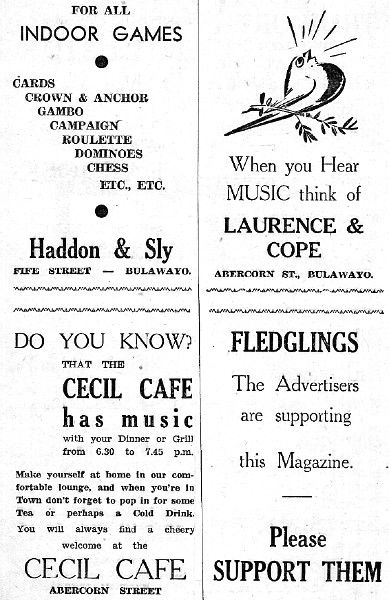
Extracted and recompiled by Eddy Norris for use on Our Rhodesian Heritage Blog from scanned material that was made available by Rusty Theobald. Thank you Rusty.
Comments are always welcome, please send them to Eddy Norris at orafs11@gmail.com
To view the Blog Home Page - Please Click Here.
(Please visit our previous posts and archives)

